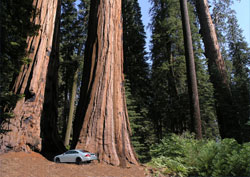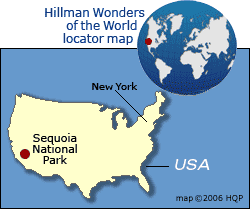Sequoia National Park
 Why the
Sequoia National Park
is special
Why the
Sequoia National Park
is specialThis California wonder has the world's grandest sequoia groves.
One tree - the General Sherman - measures 83 meters (275 feet) high and 31 meters (103 feet) in circumference, making it the earth's largest living tree in terms of volume.
Sequoia National Park tips and insights
Top attraction: Giant Forest
If you visit only one grove in Sequoia National Park, make it Giant Forest. The General Sherman tree lives here, as do many other massive specimens. The Giant Forest has a one-hour paved trail for exploring the towering trees. Some are 2,000 years old.
Other interesting attractions include
- Tunnel Log
Drive through a tunnel carved through a giant tree that fell across a road.
- Crescent Meadow
The famous 19th century conservationist John Muir called Crescent Meadow the "Gem of the Sierra". It's still unspoiled. - Moro Rock
Climb 400 steep steps up this domed rock for a breathtaking view of the surrounding landscape. - Tharp's Log
A 19th century settler built his cabin inside a fire-hollowed fallen sequoia. - Crystal Cave
Tour a cavern composed of marble, complete with stalagmites and stalactites.
The sequoia covered much of North America until most were toppled over by glaciers 10,000 years ago during the last ice age.
Destruction by man
During the second half of the 19th century, loggers cut down some of the majestic sequoias in an area called Big Stump Basin that lies northwest of the park. The fallen trees were sprouting seeds when Rome was in its glory.
Interesting tidbits
Did you know?
- Roots
Sequoia trees have an unusually shallow root system for their size. - Growth
Nearly all the existing trees are still growing, including the largest, General Sherman.
Sequoias have a larger girth and volume. Redwoods are taller, and have a fluted instead of a motley bark pattern.
Location in America



